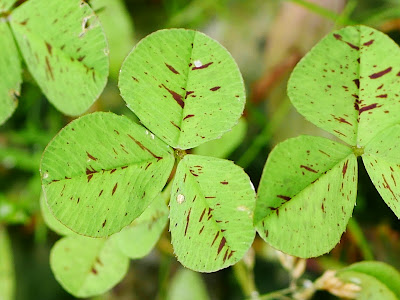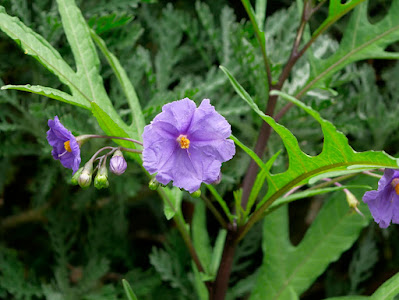As Summer marches on, species coming into flower change and the Spring plants fade away. The following plants are some that I photographed this month in Cornwall on my recording trips. It's a bit longer than most blogs, but I didn't want to leave out too many of the special plants, of which there were many!
There are two Hemp-nettles and when not in flower, I can't tell them apart. The only real difference is that Bifid Hemp-nettle has a cleft in its lower petal and usually is quite pink compared to the Common Hemp-nettle which doesn't have a cleft lower petal and its flowers are mostly white. Both are coming into flower now and below is the Bifid Hemp-nettle. They're quite attractive flowers, but generally quite small on a large plant.
Galeopsis bifida
There are several species of wild Geranium family species that grow in the UK, but they are supplemented by garden escapes. One of the commonest escapes found in the wild is the hybrid between French and Pencilled Cranesbill which is often found not far from habitation in the wild. There are a huge amount of alien species growing in the wild in Cornwall and as a non gardener, getting to know them all is a new challenge for me.
Geranium x oxonianum
The next few photos are from a Cornwall Botany Group field trip to Bodmin Moor. Much of the moor is overgrazed, but a lack of grazing would likely be worse as Gorse and Bracken would then dominate the whole moor. There are pockets of plants where the livestock couldn't reach and the short sward also favoured tiny plants like this Heath Pearlwort below. From above it looked like Procumbent Pearlwort, but the leaf arrangement is different; the leaves are hairy (you need an eye loupe to see them) and the flowers have larger petals (difficult to see as closed up due to it raining).
Sagina subulata
The main purpose of this field trip was to see and count the populations of two rare ferns, Tunbridge Filmy Fern and Wilson's Filmy Fern. We found both in the same crevice between huge granite boulders near a stack of rocks called The Cheesewring. It was such a small crevice that I had to point the camera and take a photo without being able to see the viewfinder or screen on the camera. I also had to use a flash, so this was the best I could get. First time I'd ever seen either of these species.
Hymenophyllum tunbrigense
The other fern was Wilson's Filmy Fern.
Hymenophyllum wilsonii
The poor thin soils are ideal for Birdsfoot, a tiny pea family plant with even tinier flowers. It mostly flowers in late Spring and the flowers are a bit bigger then, but these plants are up on the moor and have a much harsher climate to contend with than its lowland brethren.
Ornithopus perpusillus
Hiding under some granite was a clump of New Zealand Willowherb, now a widespread alien species in Cornwall.
Epilobium brunnescens
On the way home I stopped off and found some odd looking Clover leaves. They had black lines along them. On researching this I found that White Clover can have a wide variety of leaf markings as shown below. "b" is the type I commonly see here. There's always new things to learn in botany, even with supposedly common species.
Trifolium repens
Late Summer means that the heaths are awash with colour now from Heather and Bell Heather. Joining them soon will be Cornish Heath and Western Gorse and coastal areas like The Lizard and Land's End will be spectacular to see.
Heather - Calluna vulgaris
Bell Heather - Erica cinerea
Wild Thyme is still flowering and these plants that I found at Kitt Hill near Callington had quite striking white markings. The coastal plants seem to lack this two tone effect.
Thymus drucei
In Kent, Fairy Flax was a plant of the short chalk turf and wasn't often found elsewhere. As such, I assumed it was a calcareous loving plant, but no. There is precious little calcareous grassland in Cornwall, yet Fairy Flax is quite at home on many neutral to slightly acidic soils here. This species is tiny with flowers only a few millimetres across; the weight of a raindrop on this flower has caused the whole plant to droop over.
Linum catharticum
It's the time for Michaelmas Daisies to flower too. They are a tricky group to identify to species level, so I thought I'd add this photo of one I found below to show you what you need to look at before attempting to use a wildflower key. A photo of the flower wouldn't be any use.
Laye Michaelmas Daisy - Symphotrichum x versicolor
The next series of photos relate to another field trip with the Cornwall Botany Group led by me (of all people) with a brief to identify as many Glassworts as we could growing in the saltmarshes at Hayle. Not one, but two Vice County Recorders were present, so no pressure then! The field trip went well surprisingly, though Glassworts were thin on the ground as regards species variety. But of course, we found lots of other plants as well, like this pink variety of Hedge Bindweed, a first for me. The recent rain set off the photo composition beautifully.
Calystegia sepium subsp roseata
The best find on this trip for me was coming across four clumps of Purple Ramping Fumitory. Perhaps the most attractive of our Fumitories, it had eluded me at previously known sites and ironically it was at a new site here. What a beautiful plant.
Fumaria purpurea
Looking at Long-stalked Glasswort at Hayle
The VCRs found us two new species of Rush to see as well. We saw the slender Saltmarsh Rush (Juncus gerardii) and below, the Frog Rush - Juncus ranarius
True to form for Cornwall, there were several alien species to see on this trip too. We saw several Kangaroo Apples growing wild along a path.
Solanum aviculare
This white flowered sorrel posed a headache for our two VCRs, so a sample was taken home for study along with some bulbils from the soil. It turned out to be Broadleaved Sorrel - Oxalis latifolia
Regarding Glassworts, we only found Common, Purple and Long-stalked. About a kilometre away was some Perennial Glasswort but we ran out of time to see those. What was surprising was that only a few years ago Long-stalked Glasswort first arrived in the Hayle eastuary. Now there were hundreds of thousands of them; it had a massive population explosion in less than a decade.
Salicornia dolychostachya
When the field trip ended I drove the short distance to The Lizard Downs for a look around. Cornish Heath was still flowering in white, pink and all in between colours.
Erica vagans
Great Burnet is quite common here.
Sanguisorba officinalis
Gorse doesn't like it much on The Lizard Downs, but Western Gorse takes over instead. It's usually a low growing spindly looking bush, often windswept into a cushion shape. It has smaller and weakly grooved spines and flowers in late Summer only, unlike its cousin Common Gorse.
Ulex gallii
In a cattle field I came across around 30 of these perplexing plants that I'd never seen before. I took a sample and on getting home found them to be an alien plant called Toothed Fireweed. It's like a giant Groundsel (to which it is related) but it smells quite vile, like gone off disinfectant! Apparently, it has gained a hold on the Isles of Scilly and is seemingly invasive. It's now appeared on The Lizard and a few other places in Cornwall too. As it efficiently disperses its seeds by wind, I can't see it being stopped now. Keep an eye out for it.
Senecio minimus
That wraps up August. I'm sorry it was a bit long, but then there was a lot going on this month in Cornwall's wildflower heaven. Hope to see you soon.
Take Care
Dave
Follow me on "X" - @Botany2021




























































